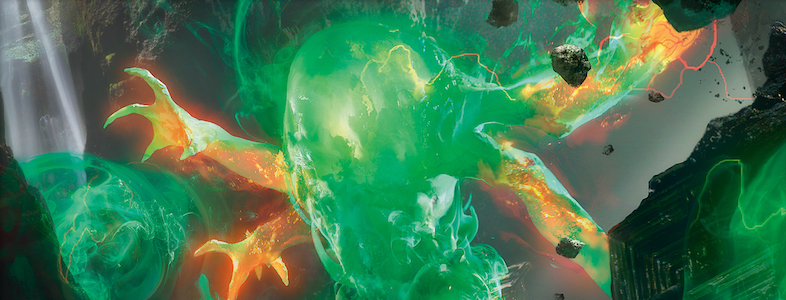Hocus Pocus Locus
Hi everyone! Welcome back to the Knowledge pool!
Way back in September I introduced a two part series discussing a few of the different flavors of land based decks in Commander. Last time our focus was Tatyova, Benthic DruidTatyova, Benthic Druid, and we talked about the Simic color combination and the advantages that it offers a "lands matter" strategy in Commander. I pointed out how access to blue, and its incredible capacity to draw cards, makes cards like BurgeoningBurgeoning and ExplorationExploration easy inclusions in a deck, representing additional value at each stage in the game. Alongside Tatyova, these spells can put a game out of reach early, offering insurmountable card and board presence.
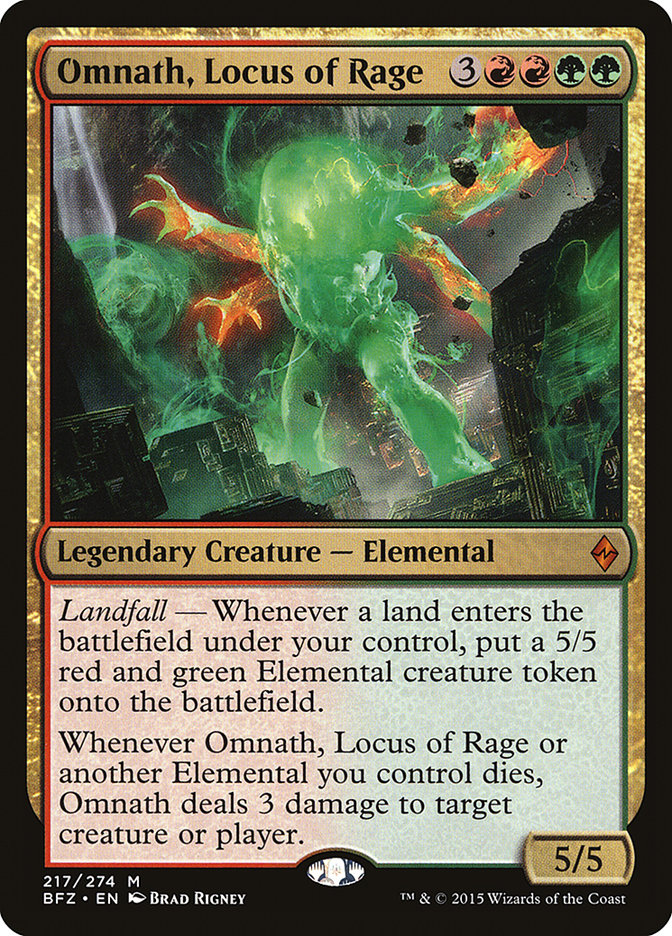
This time, we're going to take the lands strategy in a slightly different direction and look at a Gruul strategy helmed by Omnath, Locus of RageOmnath, Locus of Rage. What Omnath may lack in card drawing ability (at least in comparison to Tatyova) it makes up for with its explosiveness and potent ability to close out a game. Traditional Commander theory divides commanders into two categories: enablers and payoffs. Tatyova more clearly fits into the category of "enabler," offering us the perfect engine for our value machine. Omnath, in contrast, is a classic example of a "payoff" commander, threatening to end the game almost instantly when he enters play. Another difference between Omnath and Tatyova are the toys that each get to play with. In an Omnath deck, your ExplorationExploration is much more likely to decline in usefulness without a consistent influx of cards. "But Scot," you say, "Omnath still needs to put lots of lands into play!" And you're correct dear reader - we will be putting many lands into play. We're just going to cheat them into play in a different way.
Omnath is a fairly simple commander, and one the format's most popular according to EDHREC. Each land that we play represents five additional power in the form of an Elemental, and each time one of our Elementals dies, token or otherwise, we get to dish out 3 damage. This means that by playing a high density of fetchlands and ramp spells, we can amass a giant board with little effort, and with a sacrifice outlet, we also threaten to burn our opponents to the ground. The aspect of this deck that was most astonishing to me was just how quickly we can build a board, and how much damage that board represented with a little bit of help. In many respects, I've observed Omnath to play not unlike a combo deck, entering play, making a handful of Elementals, swinging for a staggering amount thanks to haste enablers, and then sacrificing the board to wipe out at least one player at the table.
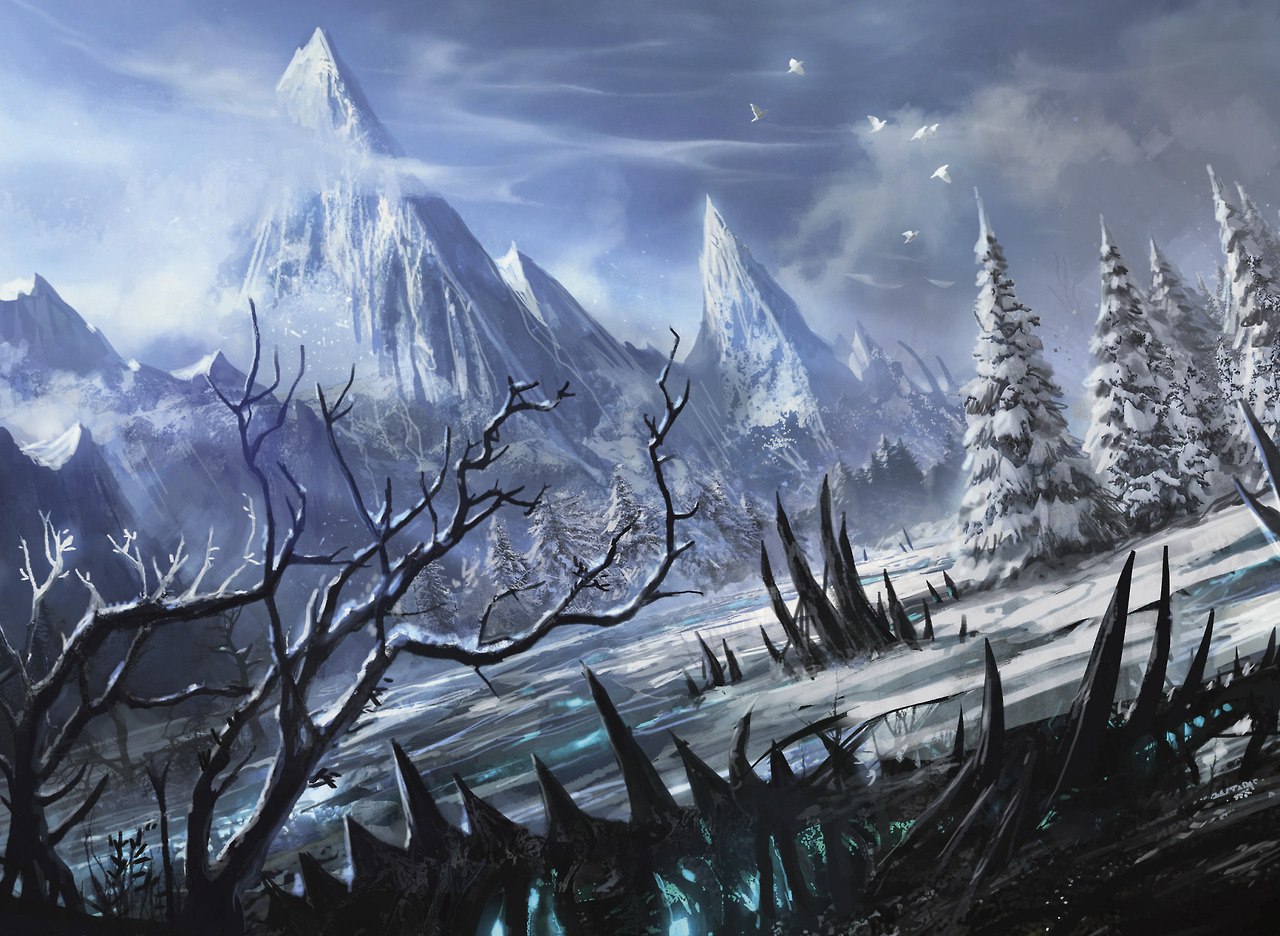
Typically in this series I present an optimized or semi-optimized 75% deck. I've bucked this trend in the past to demo decks like Yennett, Cryptic SovereignYennett, Cryptic Sovereign, and my Omnath deck will offer yet another perspective on the budget deck building process. I completed Yennett using a "potluck" style of deck building, aiming to build a budget deck based on the cards in my collection. Conversely, Omnath was originally built as a challenge to see how powerful of a deck I could build for under $100. Very quickly, testing revealed that even on a budget, Omnath was a formidable beast. I adored my budget Omnath deck, not only because it was my first land-focused deck, but because it exceeded all of my wildest expectations. I was crushing decks with more tuned strategies, and doing so was a blast. Over time, I upgraded Omnath, not out of necessity for more power, but because of my devotion to the deck. It felt only fair that Omnath got new toys, seeing as he had quickly proven to be among my favorite commanders. Luckily, I had the foresight to save my original Omnath list, including the prices of each card at the time, totaling $60. Admittedly, I cheated slightly in that I used TCGplayer Low prices, but even using the Mid prices, my deck wasn't much over $80.
Today I want to show you a Commander deck in flux. We'll start by observing my original budget list, and we'll then move on to look at my current list. It may be somewhat surprising to see just how similar the budget and upgraded lists look. Beyond my current list, I'll introduce a handful of updates I plan to make in the near future. For better or worse, the Commander 2018 product brought with it rabid interest in land strategies, meaning that building a budget land deck isn't as trivial as it was when I originally designed Omnath. However, if you're interested in building a lands deck, I strongly suggest starting with Omnath. Regardless of your budget, Omnath will offer you the firepower to set your opponents ablaze.
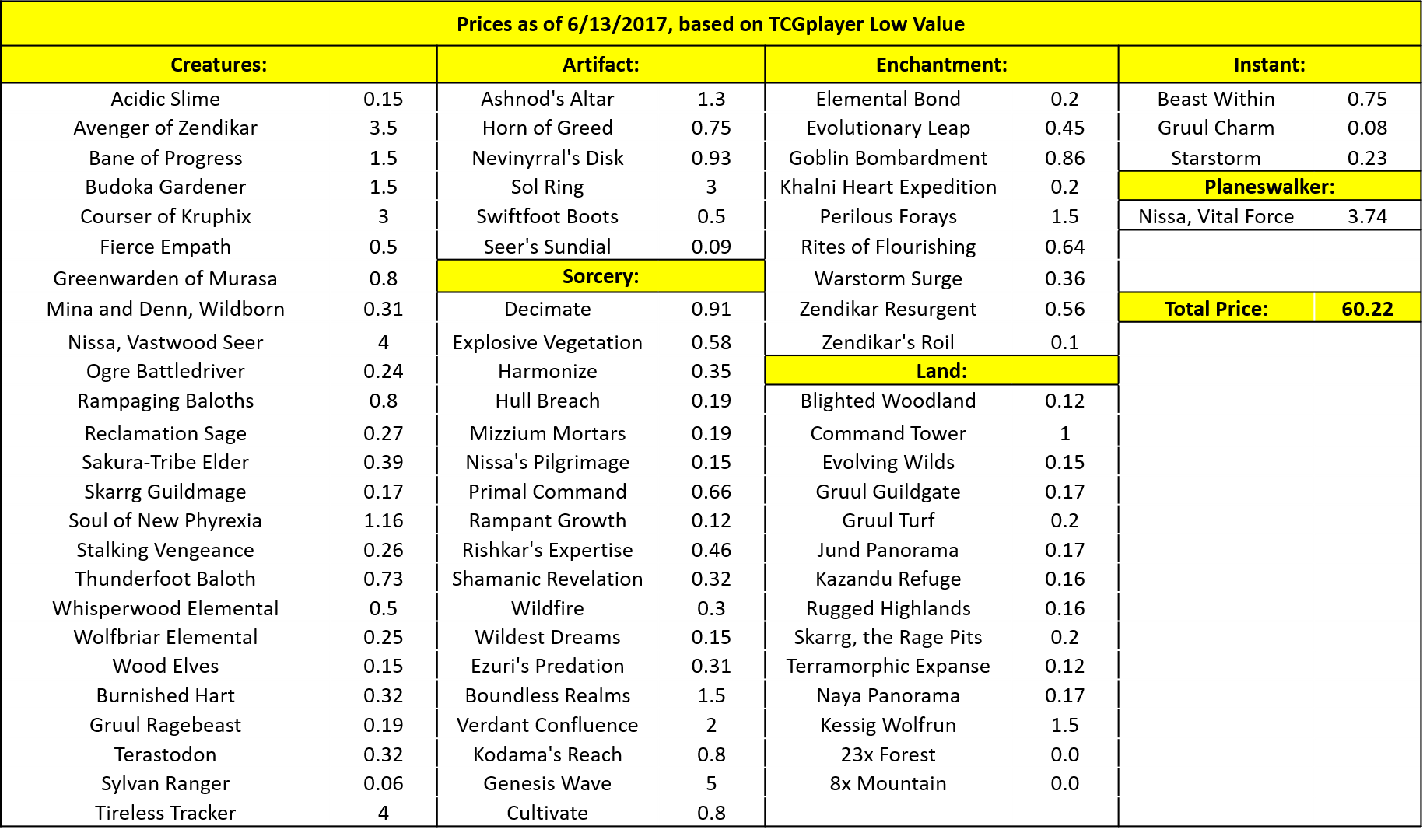
When building my original deck, I had several objectives. First, I needed to include a variety of ways to trigger Landfall, and this meant I needed creatures and spells that could put additional lands into play. I then needed to address one of the primary weaknesses Omnath faces. Even though he can put a lot of power on board, we're fairly vulnerable to removal, so I needed spells for sacrificing my creatures, giving them haste, and protecting them. The last aspect of the deck to which I devoted significant attention were supporting cards, like card draw and removal.
For this first iteration of the deck, I tried to limit the more expensive cards ($3-5 range) to those that were synergistic with the deck strategy. Courser of KruphixCourser of Kruphix seemed like a good way to filter our draws, Tireless TrackerTireless Tracker seemed like a good way to draw cards, Avenger of ZendikarAvenger of Zendikar seemed like a perfect alternate win condition, and Nissa, Vastwood SeerNissa, Vastwood Seer seemed like a good way to ensure we hit our land drops, while scaling well with the state of the game. While not directly synergistic, the most expensive card in the deck at the time was Genesis WaveGenesis Wave. This deck is about 80% permanents, so our hit rate with Wave is fairly good, and with as much mana as we're making, I quickly found that Wave was oftentimes an alternate win condition. Ultimately, though, what made Wave worth the $5 was that it often times represented a gigantic Landfall trigger, putting half a dozen or more lands into play.
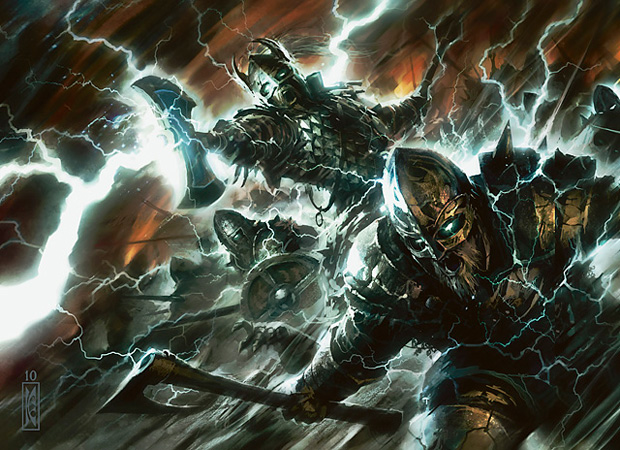
I was cautiously optimistic when I first built this deck, but it immediately began overachieving. Elemental BondElemental Bond drew tons of cards, Warstorm SurgeWarstorm Surge made wiping out a table trivial, and all of the CultivateCultivate-style effects represented tons of value. A card I had read about many times in reference to this deck was Perilous ForaysPerilous Forays, and I quickly discovered that in combination with Omnath it was easily the most powerful card in the deck. The hype was real and well-deserved. For the uninitiated, Forays lets us sacrifice a creature to search our deck for a basic land and put it into play. On its own, this ability is strong, but the six mana investment before we see our first extra land isn't too exciting. However, with Omnath, every land that Forays puts into play makes another Elemental to be sacrificed, and each Elemental is 3 more damage to our opponents. Essentially, we can put as many lands into play as we have mana, and deal 3x that much damage in the process. If the damage doesn't kill our opponents, untapping with double the mana will.

This deck is an absolute blast to play, and everything it does feels powerful. I quickly found that this was my "go to" deck, taking precedence over my more tuned decks and the decks I had owned for much longer. It wasn't perfect, but in some ways the more "sub-optimal" inclusions made it more exciting, adding a uniqueness I had lost in my deck building process through the years. This made upgrading the deck feel a tad blasphemous, like I was tainting a piece of art that was perfect in its own way. So, I decided that I would be conservative with my upgrades, making changes to patch holes and enhance explosiveness, but not tuning to the point where the new list was unrecognizable from the original.
The following is my Omnath deck as it sits in my deck box:
The Angry Orchard
View on ArchidektCreatures (25)
- 1 Budoka GardenerBudoka Gardener
- 1 Dryad GreenseekerDryad Greenseeker
- 1 Sakura-Tribe ElderSakura-Tribe Elder
- 1 Skarrg GuildmageSkarrg Guildmage
- 1 Burnished HartBurnished Hart
- 1 Courser of KruphixCourser of Kruphix
- 1 Eternal WitnessEternal Witness
- 1 Nissa, Vastwood SeerNissa, Vastwood Seer
- 1 Ramunap ExcavatorRamunap Excavator
- 1 Reclamation SageReclamation Sage
- 1 Tireless TrackerTireless Tracker
- 1 Wood ElvesWood Elves
- 1 Mina and Denn, WildbornMina and Denn, Wildborn
- 1 Ogre BattledriverOgre Battledriver
- 1 Acidic SlimeAcidic Slime
- 1 Titania, Protector of ArgothTitania, Protector of Argoth
- 1 Bane of ProgressBane of Progress
- 1 Greenwarden of MurasaGreenwarden of Murasa
- 1 Rampaging BalothsRampaging Baloths
- 1 Soul of New PhyrexiaSoul of New Phyrexia
- 1 Thunderfoot BalothThunderfoot Baloth
- 1 Avenger of ZendikarAvenger of Zendikar
- 1 Gruul RagebeastGruul Ragebeast
- 1 Stalking VengeanceStalking Vengeance
- 1 TerastodonTerastodon
Artifacts (7)
- 1 Sol RingSol Ring
- 1 Lightning GreavesLightning Greaves
- 1 Swiftfoot BootsSwiftfoot Boots
- 1 Ashnod's AltarAshnod's Altar
- 1 Crucible of WorldsCrucible of Worlds
- 1 Nevinyrral's DiskNevinyrral's Disk
- 1 Seer's SundialSeer's Sundial
Enchantments (10)
- 1 Evolutionary LeapEvolutionary Leap
- 1 Goblin BombardmentGoblin Bombardment
- 1 Khalni Heart ExpeditionKhalni Heart Expedition
- 1 Elemental BondElemental Bond
- 1 Rites of FlourishingRites of Flourishing
- 1 Parallel LivesParallel Lives
- 1 Perilous ForaysPerilous Forays
- 1 Where Ancients TreadWhere Ancients Tread
- 1 Zendikar's RoilZendikar's Roil
- 1 Warstorm SurgeWarstorm Surge
Sorceries (15)
- 1 FarseekFarseek
- 1 Hull BreachHull Breach
- 1 CultivateCultivate
- 1 Genesis WaveGenesis Wave
- 1 Kodama's ReachKodama's Reach
- 1 Nissa's PilgrimageNissa's Pilgrimage
- 1 DecimateDecimate
- 1 Explosive VegetationExplosive Vegetation
- 1 ScapeshiftScapeshift
- 1 Shamanic RevelationShamanic Revelation
- 1 Traverse the OutlandsTraverse the Outlands
- 1 Rishkar's ExpertiseRishkar's Expertise
- 1 Verdant ConfluenceVerdant Confluence
- 1 Boundless RealmsBoundless Realms
- 1 Blasphemous ActBlasphemous Act
Instants (2)
- 1 Beast WithinBeast Within
- 1 Second HarvestSecond Harvest
Lands (36)
- 1 Blighted WoodlandBlighted Woodland
- 1 Cinder GladeCinder Glade
- 1 Command TowerCommand Tower
- 1 Evolving WildsEvolving Wilds
- 1 Fire-Lit ThicketFire-Lit Thicket
- 14 ForestForest
- 1 Game TrailGame Trail
- 1 Jund PanoramaJund Panorama
- 1 Karplusan ForestKarplusan Forest
- 1 Kessig Wolf RunKessig Wolf Run
- 6 MountainMountain
- 1 Myriad LandscapeMyriad Landscape
- 1 Naya PanoramaNaya Panorama
- 1 Rootbound CragRootbound Crag
- 1 Sheltered ThicketSheltered Thicket
- 1 Spire GardenSpire Garden
- 1 Stomping GroundStomping Ground
- 1 Terramorphic ExpanseTerramorphic Expanse
The Breakdown
Our deck is sitting at an average CMC of 4.02. Given the amount of ramp we're playing, we can afford a curve this high with the realistic expectation that we'll be casting most of our spells several turns early.
Much like my original list, this deck is primarily made up of ramp spells, and spells that let us trigger Landfall. We also still have a small suite of cards to give our creatures haste and trample, and cards to offer our creatures protection. We're also fairly dense on removal spells and draw spells, so we should be fairly capable when interacting with the board.
The upgrades from the original list to this one happened in waves. Unfortunately, I don't have a timeline of when particular cards were added, but most additions took place as a result of me adding new cards to my collection. Several changes happened out of necessity; for instance, I swapped in Blasphemous ActBlasphemous Act over Ezuri's PredationEzuri's Predation so that I wouldn't have as much trouble casting my Wraths. Other edits were the result of reprints, cutting the prices of certain cards like Crucible of WorldsCrucible of Worlds and ScapeshiftScapeshift. Of course neither of these cards are necessary for this deck, but both are nice additions for bolstering consistency and explosiveness, respectively. I also added in a few cards to the deck after some initial testing. I realized how good Warstorm SurgeWarstorm Surge was, and how it was a critical piece in pushing damage through. For redundancy I added in Where Ancients TreadWhere Ancients Tread, and I also aimed to double my token output with Parallel LivesParallel Lives. Both of these options are arguably "win more," but in Commander, a little "win more" can help you maintain hold of a victory.

Nissa, WorldwakerNissa, Worldwaker was added in as a form of ramp and because the Elementals she makes become more burn damage to hurl around. Similarly, Chandra, FlamecallerChandra, Flamecaller offers us more Elementals, card draw, and creature removal. The final area of upgrades, and perhaps most frivolous, is in the land category. I swapped out ETB tapped duals and a few basics for a handful of more efficient lands. I mentioned in my Yennett article that the bulk of the price was maintained by the manabase, and Omnath is similar in this respect. You could shave off a significant chunk of this deck's cost by switching back to my previous manabase, and in few occasions will the change be relevant.
Now that we've addressed a few of the changes, let's take a look at what we're actually playing with, and how I categorize the cards in this deck starting with ramp and landfall.
Bountiful Growth
Ramp and Landfall
View on Archidekt- 1 Sol RingSol Ring
- 1 Budoka GardenerBudoka Gardener
- 1 Dryad GreenseekerDryad Greenseeker
- 1 Khalni Heart ExpeditionKhalni Heart Expedition
- 1 Sakura-Tribe ElderSakura-Tribe Elder
- 1 Burnished HartBurnished Hart
- 1 Courser of KruphixCourser of Kruphix
- 1 CultivateCultivate
- 1 Genesis WaveGenesis Wave
- 1 Kodama's ReachKodama's Reach
- 1 Nissa's PilgrimageNissa's Pilgrimage
- 1 Rites of FlourishingRites of Flourishing
- 1 Wood ElvesWood Elves
- 1 Explosive VegetationExplosive Vegetation
- 1 Mina and Denn, WildbornMina and Denn, Wildborn
- 1 ScapeshiftScapeshift
- 1 Perilous ForaysPerilous Forays
- 1 Traverse the OutlandsTraverse the Outlands
- 1 Verdant ConfluenceVerdant Confluence
- 1 Boundless RealmsBoundless Realms
For the most part, the cards in this section should be standard fare as Commander ramp spells. I've already briefly discussed the utility of a few of the spells on this list, but I would like to highlight a few that might seem a bit more unusual. Before I do, I would like to point out an aspect of the Landfall package that are not highlighted above: fetchlands. When I mention fetchlands, more enfranchised players will likely immediately think of the lands printed in Onslaught and Zendikar that demand prices ranging from $35-100 each. While these lands are incredible, and you should play them if you have them, we've also been given a variety of cheap alternatives that can easily make the cut here, acting as cheap (and often free) alternatives for attaining Landfall triggers. In addition, these cards also interact favorably with a few other cards in the deck, such as Crucible of WorldsCrucible of Worlds letting us replay them over and over and Titania, Protector of ArgothTitania, Protector of Argoth offering us more Elementals. For this deck, the lands I've chosen are: Blighted WoodlandBlighted Woodland, Evolving WildsEvolving Wilds, Jund PanoramaJund Panorama, Myriad LandscapeMyriad Landscape, Naya PanoramaNaya Panorama, and Terramorphic ExpanseTerramorphic Expanse.
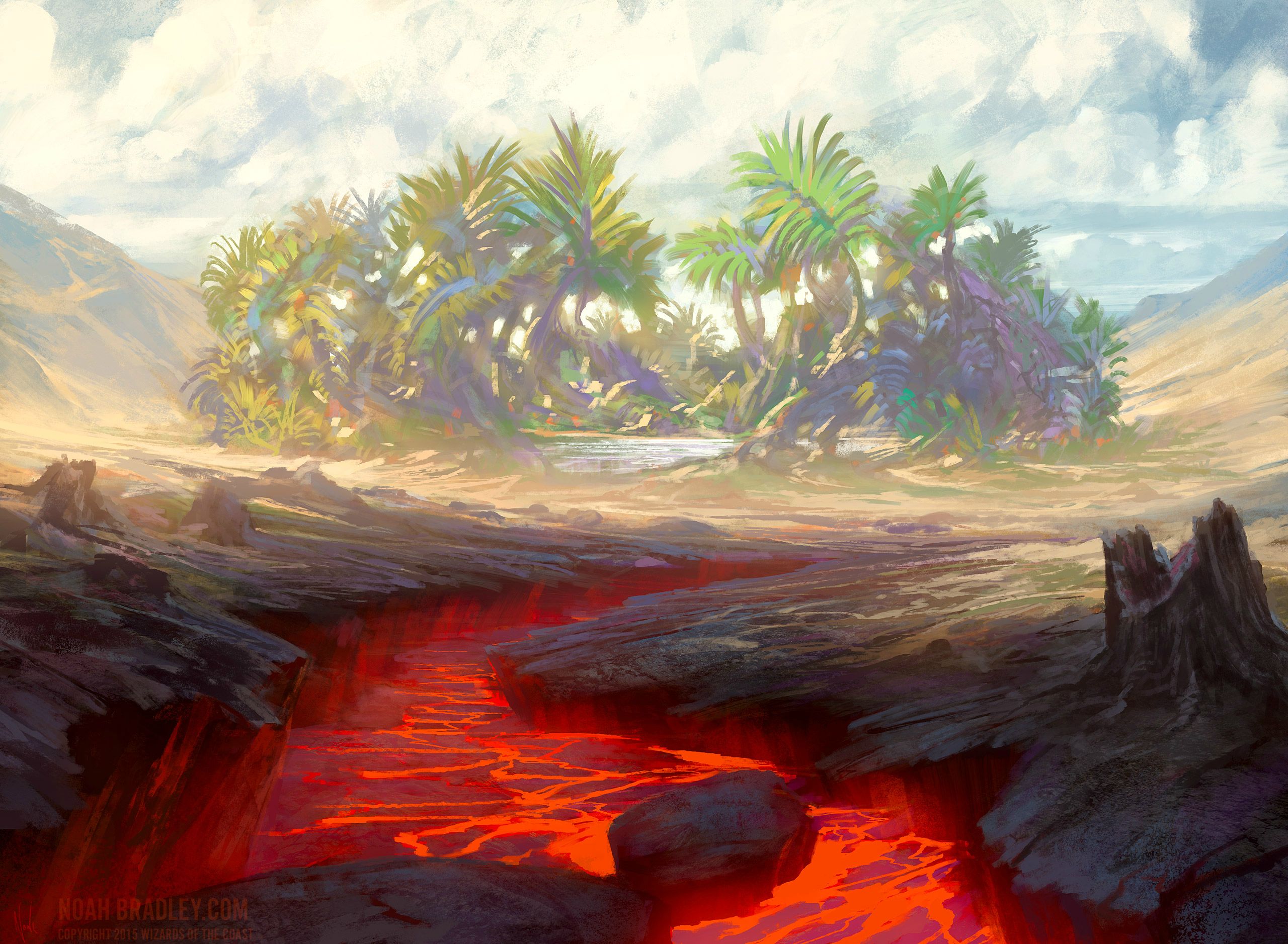
I've been a huge fan of Dryad GreenseekerDryad Greenseeker since its initial spoiling, and I feel like it can do a lot of work in a deck like this. In the past I've acknowledged my fondness for cheap, wall-like creatures that offer value over time. Over the course of a game, if Greenseeker can "draw" us even one additional card, we've gotten good value for our initial investment. Any additional cards we draw are exceeding expectations. In many ways, we can think of Greenseeker as a variant of Courser of KruphixCourser of Kruphix, helping us filter the top of our deck of lands so that we can get to the more important spells.
Khalni Heart ExpeditionKhalni Heart Expedition may seem slow, but for a deck like this, it's a solid investment. In my experience, we will manage to pop the Expedition rather quickly, making it more viable as a ramp spell than it might initially appear, but we can also play with it in mind so that we can turn it into two additional land drops with Omnath on board.
Mina and Denn WildbornMina and Denn Wildborn and Rites of FlourishingRites of Flourishing seem like the types of cards that I warned against playing in the intro. However, there are clear reasons for including both. The Wildborn duo has the option to bounce our lands in exchange for giving our creatures trample, an ability our creatures are thrilled to have anyway. In this way, Mina and Denn can fuel themselves, and aren't reliant on us holding additional lands to get use of their ability. Rites of Flourishing lets us draw an extra card, which will make hitting the extra land drop easier. The fact that each land drop has the potential to be quite powerful in this deck helps us break the symmetry that Flourishing offers. I also want to note that I replaced Horn of GreedHorn of Greed with Flourishing. In theory, Horn seems like a perfect inclusion for a deck like this, but because it requires lands to be "played" and my design of Omnath focuses on ramp spells, it tends not to synergize particularly well.
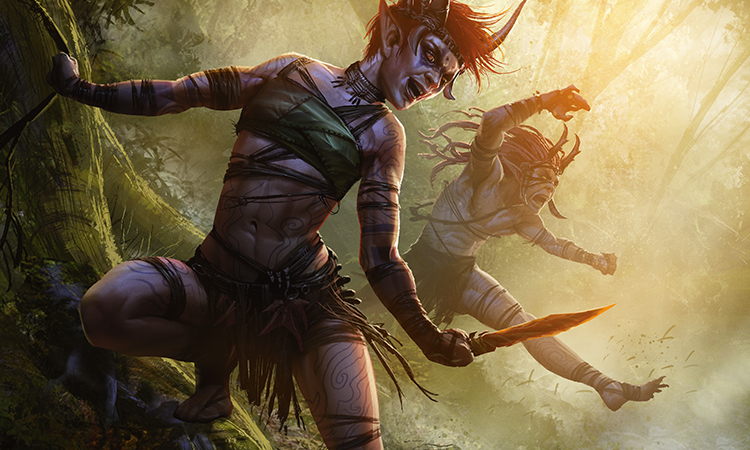
The last card I want to point out is Verdant ConfluenceVerdant Confluence. When Confluence came out, I remember thinking that the cost of the ability was steep, especially considering a Boundless RealmsBoundless Realms is only one more mana. However, what made me reconsider Confluence for this deck is the recursion aspect. Our deck is primarily permanents, and there will be games where some of our more important ones get blown out. I like Confluence for these situations to return a Perilous ForaysPerilous Forays or Warstorm SurgeWarstorm Surge. And in the worst case scenario, Confluence is a triple Rampant GrowthRampant Growth, representing 15 additional power alongside Omnath.
The next step of this deck that I want to cover are the spells that will make our army tick. Let's talk about protection, haste, and trample.
Built to Smash
Haste and Trample
View on ArchidektHaste (3)
- 1 Swiftfoot BootsSwiftfoot Boots
- 1 Lightning GreavesLightning Greaves
- 1 Ogre BattledriverOgre Battledriver
Trample (3)
- 1 Skarrg GuildmageSkarrg Guildmage
- 1 Mina and Denn, WildbornMina and Denn, Wildborn
- 1 Thunderfoot BalothThunderfoot Baloth
Protection (3)
- 1 Lightning GreavesLightning Greaves
- 1 Swiftfoot BootsSwiftfoot Boots
- 1 Soul of New PhyrexiaSoul of New Phyrexia
Sac-Outlet (4)
- 1 Evolutionary LeapEvolutionary Leap
- 1 Goblin BombardmentGoblin Bombardment
- 1 Ashnod's AltarAshnod's Altar
- 1 Perilous ForaysPerilous Forays
In large part, this is a section of enablers. We know that once Omnath arrives, and starts raining Elementals on the field, we're going to become a primary target. With this in mind, we need to be able to capitalize and begin dealing damage as quickly as possible.
Our protection and haste options are largely overlapping. Ogre BattledriverOgre Battledriver is the only haste anthem we have, while Lightning GreavesLightning Greaves and Swiftfoot BootsSwiftfoot Boots will let us pass around haste selectively. I made these choices because having a cheap way of protecting Omnath from spot removal could easily make the difference between winning and losing a game.
Rather than protecting our Elemental army, in most cases I would rather just sacrifice them to punish anyone who might try to mess with us. Evolutionary LeapEvolutionary Leap will let us replace each of our sacrificed Elementals with a creature in hand, Goblin BombardmentGoblin Bombardment will squeeze out a bit of extra damage from each Elemental, and Ashnod's AltarAshnod's Altar will let us sacrifice our tokens proactively to play into some of our bigger spells.
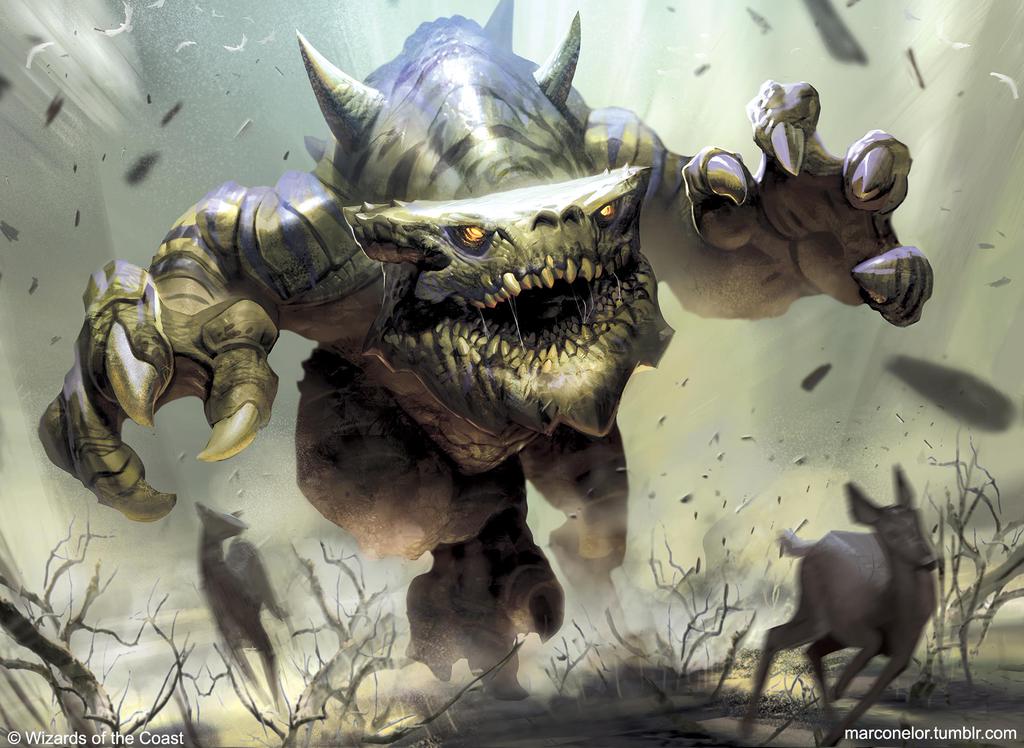
Of our trample enablers, Thunderfoot BalothThunderfoot Baloth is the most potent. If our dudes have survived a turn around the table, we can drop Baloth and have a solid chance to attack for tons of damage.
I always talk about the cards in my decks that are playing a supporting role, and this section tends to fall into that category. However, we also have our more traditional supporting cast of removal and draw, and we'll go over them next.
The Glue
Draw and Removal
View on ArchidektDraw (8)
- 1 Courser of KruphixCourser of Kruphix
- 1 Elemental BondElemental Bond
- 1 Rites of FlourishingRites of Flourishing
- 1 Tireless TrackerTireless Tracker
- 1 Seer's SundialSeer's Sundial
- 1 Shamanic RevelationShamanic Revelation
- 1 Chandra, FlamecallerChandra, Flamecaller
- 1 Rishkar's ExpertiseRishkar's Expertise
Removal (11)
- 1 Hull BreachHull Breach
- 1 Mizzium MortarsMizzium Mortars
- 1 Beast WithinBeast Within
- 1 Reclamation SageReclamation Sage
- 1 DecimateDecimate
- 1 Nevinyrral's DiskNevinyrral's Disk
- 1 Acidic SlimeAcidic Slime
- 1 Bane of ProgressBane of Progress
- 1 Chandra, FlamecallerChandra, Flamecaller
- 1 Gruul RagebeastGruul Ragebeast
- 1 Blasphemous ActBlasphemous Act
Of our draw spells, Elemental BondElemental Bond and Tireless TrackerTireless Tracker have pulled the most weight for me. Bond cares about creatures entering the battlefield, so every Elemental we make with Omnath draws us a card. We can essentially think of Elemental Bond as reading, "Whenever a land enters the battlefield under your control, draw a card." Tireless Tracker does a great job of accumulating value, and having the ability to turn a few leftover mana each turn into card draw could give us the edge long term.
From a removal standpoint, we have about equal parts creature removal and artifact/enchantment removal. Nevinyrral's DiskNevinyrral's Disk is a card I originally included in my budget list because of its low cost, but it has shown its value over a handful of games. Having the ability to hit most major permanent types is huge, and there have even been games where I've replayed a Disk a second time thanks to Eternal WitnessEternal Witness. If our opponents are running a bit faster than us, a card like Disk is a good, if vulnerable, equalizer.
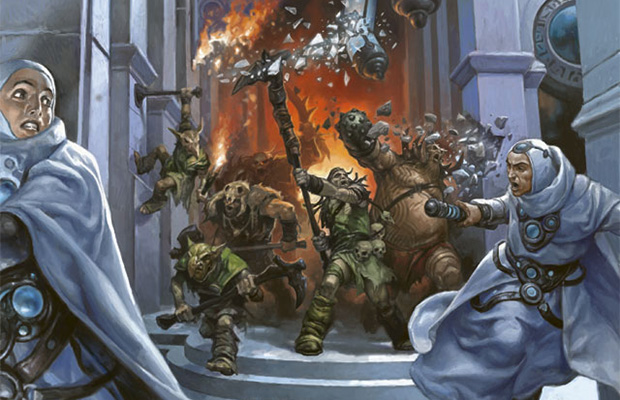
DecimateDecimate has gotten increased appreciation over the years, and I've had this card win me games on several occasions. Oftentimes you'll remove four of the scariest permanents at the table, but on occasion you can really punish a player who has overextended.
Lastly, Gruul RagebeastGruul Ragebeast may seem like a strange choice, but even on its own, it represents creature removal. If we can get Ragebeast and Omnath on board at the same time, odds are we'll be able to kill any other creature after a couple land drops.
Future Edits
I pointed out that the deck I'm presenting today isn't finished. In fact, as I was revisiting my deck for this article, I noticed several changes I would like to make.
First, my recent testing with Riku of Two ReflectionsRiku of Two Reflections has shown me the power of HarrowHarrow. For three mana we can net two land drops and two untapped mana while ramping by one at instant speed. The easy swap for this card is Burnished HartBurnished Hart, which requires six mana to get two land drops, and doesn't synergize otherwise with our deck.
The inclusion of Soul of New PhyrexiaSoul of New Phyrexia was always a concession to the fact that we want Omnath to survive more than one turn. However, the costly nature of Soul made it cumbersome, and an easy candidate to be replaced by a more efficient option. Heroic InterventionHeroic Intervention offers us better protection for two mana at instant speed. Unlike Soul, our opponents will have a much harder time playing around Intervention, and the low cost will give us the option to slow-roll Omnath until we can guarantee his protection.
TerastodonTerastodon is big and can take out several important permanents. However, it lacks synergy with our deck. Instead, I would like to swap in Multani, Yavimaya's AvatarMultani, Yavimaya's Avatar, which is cheaper and likely bigger than Terastodon, and comes with reach, trample, and the ability to bounce our lands so we can reaply them for more Landfall.
Battlebond gave us a reprint of Greater GoodGreater Good. Those of you familiar with my articles are aware of how much I love this card, and I'm loving it even more now that it costs a third of its previous price. In this deck, Greater Good represents additional draw power and a free sac outlet, two things we're desperate for. Because I want to swap by functionality, I plan to swap in Greater Good for Evolutionary Leap.
Speaking of reprints, let's talk about Oblivion StoneOblivion Stone. I mentioned how I was rather fond of Nevinyrral's DiskNevinyrral's Disk, with the caveat that it coming into play tapped gives our opponents a big window to answer. Stone can come into play and wrath the board in the same turn, and has the added benefit of taking down Planeswalkers too. The costs for these advantages are three mana and $3. For us, the three mana is generally trivial, but when I built this deck, the price was the much bigger concern. Now that Stone is significantly cheaper thanks to its Iconic Masters printing, the $4.50 price tag isn't too challenging to swallow, and I plan to swap this in for Disk.

Another new card from Dominaria is Broken BondBroken Bond. On first reading, I was ecstatic about this card. A strictly better NaturalizeNaturalize? Sign me up! Then I read it was a sorcery. Oh. Sorcery speed isn't the worst thing in the world, and two mana is competitive enough that we won't be setting ourselves back too far by playing it on our turn. The fact that it can get us an additional land drop seems great, although admittedly, I'm not certain how often it will outside of the first few turns. I'm on the fence with this card, in large part because I don't have a great cut for it. To me, it seems like the most obvious swap for Broken Bond is Reclamation SageReclamation Sage, given that the body on Reclamation Sage isn't super useful to us. However, unlike the other upgrades, this one isn't an easy swap for me. I might test this one out a bit and see how it feels, or I might just leave the deck as is.
Lastly, if we ever receive a reprint of Oracle of Mul DayaOracle of Mul Daya, I would love to have one in this deck. Being able to play lands from the top of our deck is huge, and makes hitting additional land drops easier. I've yet to plan for exactly what I'll bump once Oracle is more affordable, but presumably it will be a card with a similar function (perhaps Rites of FlourishingRites of Flourishing). Come on WoTC, put Oracle in Ultimate Masters. You know you want to. Please.
Wrapping Up
Thanks again for tuning into another episode of The Knowledge Pool!
Next time I plan to bring you a deck that a friend of mine has recently built, and I'm going to be putting a budget twist on it. While this series won't always focus on budget brewing, I feel like addressing it from time to time helps add unique constraints to our deck building process that can help us find creative solutions for the future.
Until next time, I wish you all the best and happy brewing!
Scot Sutton
I'm a Timmy that loves Green, Creatures, and Lands. I prefer controlled smashing, and best associate with the Temur colors. I've been playing commander since 2012, and I spend my free time brewing decks and exploring new strategies. I'm also a sports nut, and follow baseball, football, hockey, and soccer in detail.
Your opinions are welcome. We love hearing what you think about Magic! We ask that you are always respectful when commenting. Please keep in mind how your comments could be interpreted by others. Personal attacks on our writers or other commenters will not be tolerated. Your comments may be removed if your language could be interpreted as aggressive or disrespectful. You may also be banned from writing further comments.
